

Publiez vos vidéos sur iTunes U grâce au CCDMD et au site Le monde en images. Connaissez-vous iTunes U?
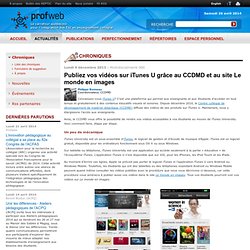
C’est une plateforme qui permet aux enseignants et aux étudiants d'accéder en tout temps et gratuitement à des contenus éducatifs visuels et sonores. L'Histoire à la carte : un atlas historique multimédia constitué de cartes animées pour mieux comprendre l'Histoire. Teaching History. Using Alternative Projects in Russian History Courses Guest blogger John Corcoran received his PhD from Georgetown University in 2012.
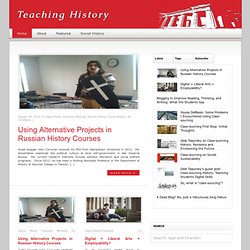
His dissertation examined the political culture of local self-government in late Imperial Russia. His current research interests include zemstvo liberalism and social welfare programs. Teaching History » Digital + Liberal Arts = Employability? In an insightful recent essay in the Chronicle of Higher Education (“No More Digitally Challenged Liberal-Arts Majors: How to give B.A.’s in arts and humanities more career options without abandoning the life of the mind”), William Pannapacker relates a number of conversations he has had with employers and institutions providing internships for students at Hope College, where he teaches.
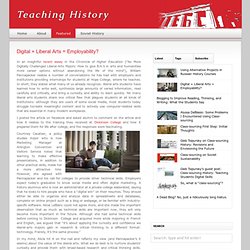
In short, they stated what many of us already recognize: liberal arts students have learned how to write well, synthesize large amounts of varied information, read carefully and critically, and bring a curiosity and ability to learn quickly. Yet many liberal arts students share one critical flaw that plagues students at all kinds of institutions: although they are users of some social media, most students today struggle tocreate meaningful content and to actively use computer-related skills that are essential in many modern workplaces. Hopefully the conversation on this topic will continue. The Center for Teaching History with Technology. Ancient Roman Sport Stars: Chariot Racers. Posted on 28.

Jan, 2014 by Brittany Britanniae in Latin Language, Roman culture Good Day Readers! So, let’s talk about some sports since the Olympics and the Super Bowl are just around the corner. While the Olympic Games were “the” competition of Ancient Greece; the chariot races were the oldest and most popular spectacle of Ancient Rome. So, we all know the iconic chariot scene from Ben Hur, but how many of you know what is inaccurate about it? An Average Race. Diana Laufenberg on Teaching History Thematically. Apr 20 2011 The Pitfalls of Chronology History is a series of events and causal relationships, stories and tragedies and successes, that when strung together weave narratives of peoples and places.
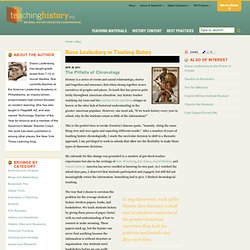
To teach this has proven quite tricky throughout American education. Any history teacher watching Jay Leno and his random trivia questions cringes in horror at the utter lack of historical understanding in the greater American populace. However, one must ask, "If we teach history every year in school, why do the students retain so little of the information? " This is the perfect time to invoke Einstein's famous quote, "Insanity: doing the same thing over and over again and expecting different results. " My rationale for this change was grounded in a number of gut-check teacher experiences but also in the writings of Sam Wineburg, Eric Foner, David Perkins, and James Loewen. The way that I choose to envision the problem for the average student of history involves papers, books, and bookshelves. In Defense of Thematic World History. I am in my second year of teaching World History.
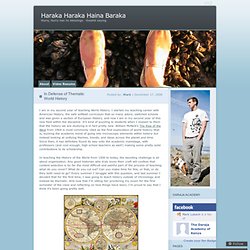
I started my teaching career with American History, the safe softball curriculum that so many adore, switched schools and was given a section of European History, and now I am in my second year of this new field within the discipline. It’s kind of puzzling to students when I explain to them that the history we are studying is in fact pretty new. William McNeill’s The Rise of the West from 1964 is most commonly cited as the first exploration of world history–that is, bucking the academic trend of going into microscopic elements within history but instead looking at unifying themes, trends, and ideas across the planet and time.
Since then, it has definitely found its way onto the academic mainstage, with professors (and cool enough, high school teachers as well!) Making some pretty solid contributions to its scholarship. In teaching the History of the World from 1500 to today, the daunting challenge is all about organization. 1. Le Profil TIC des étudiants 2014 : la démarche cognitive d’abord! Le Profil TIC des étudiants du collégial propose un ensemble d'habiletés informationnelles et technologiques essentielles aux étudiants.
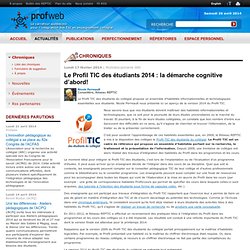
Nicole Perreault nous présente ici un aperçu de la version 2014 du Profil TIC. Nous savons tous que nos étudiants doivent maîtriser des habiletés informationnelles et technologiques, que ce soit pour la poursuite de leurs études universitaires ou le marché du travail. Et pourtant, à la fin de leurs études collégiales, on constate que bon nombre d’entre eux éprouvent des difficultés en ce sens, qu’il s’agisse de chercher et trouver l’information, de la traiter ou de la présenter correctement. C’est pour soutenir l’apprentissage de ces habiletés essentielles que, en 2009, le Réseau REPTIC a mis à la disposition des collèges le Profil TIC des étudiants du collégial. Lessons.